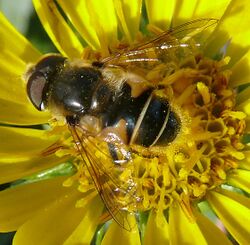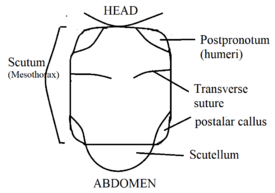Biology:Eristalis hirta
| Eristalis hirta | |
|---|---|

| |
| Scientific classification | |
| Domain: | Eukaryota |
| Kingdom: | Animalia |
| Phylum: | Arthropoda |
| Class: | Insecta |
| Order: | Diptera |
| Family: | Syrphidae |
| Genus: | Eristalis |
| Species: | E. hirta
|
| Binomial name | |
| Eristalis hirta (Loew, 1866)
| |
| Synonyms[1] | |
| |
Eristalis hirta, the black-footed drone fly, is a common Western North American species of syrphid fly first officially described by Loew in 1866.[2] Hoverflies get their names from the ability to remain nearly motionless while in flight. The adults are also known as flower flies for they are commonly found around and on flowers, from which they get both energy-giving nectar and protein-rich pollen. The larvae are aquatic filter-feeders of the rat-tailed type.[3][4][1][5][6]
Distribution
This species is found in Western North America and Northern Europe where it is found in raised bogs, ditches and temporary pools.[7]
Description
For terms see Morphology of Diptera
- Size
- Length: . 10–15 mm (0.39–0.59 in)
thumb| facial view
- Head
The frons shining black with pile light brownish yellow The face and frons of female is unusually broad. Pile of face light brownish yellow except the facial stripe (tubercle) and the cheeks which are shining black. The antennae are very dark brownish black, The arista is slightly plumose basally.The eyes are contiguous only in males.
- Thorax
The thorax is dark shining, brownish black with yellowish pile The scutellum is not quite so dark, brownish, shining The pleurae are covered with pale yellow pile.
- Legs
The legs are black and yellow: The front and middle femurs are black with pale yellow apex and hind femure base and apex yellow. The front and hind tibia are black, with the basal half or more pale yellow and middle tibia mostly pale yellow. The tarsi all black except middle leg basitarsi are yellow.
- Abdomen
The abdomen is black with yellow bands and spots. The second segment has a large, sharply marked, yellow orange spots on the sides, widely separated by opaque black medially. There are light yellow posterior marginal bands of the second third and fourth segments are unusually prominent. Segments three and four are shining black, with yellow bands posteriorly.
- Wings
The wings are hyaline, or very faintly infuscated in the middle and anterior half. The pterostigma (pt) is small. Veination: spurious vein (sv), looping of R4+5 into r4+5, closed cell r2+3.
[8][9]
References
- ↑ 1.0 1.1 "Eristalis hirta Report". https://www.itis.gov/servlet/SingleRpt/SingleRpt?search_topic=TSN&search_value=140947. Retrieved 2019-09-25.
- ↑ Osten-Sacken, Carl Robert (1877). Western Diptera : descriptions of new genera and species of Diptera from the region west of the Mississippi and especially from California. Washington: Smithsonian Institute. pp. 354. https://www.biodiversitylibrary.org/item/119039#page/167/mode/1up.
- ↑ Rotheray, G.E. (1993). "Colour Guide to Hoverfly Larvae (Diptera, Syrphidae) in Britain and Europe". Diperists Digest 9: 155. https://diptera.info/downloads/df_1_9_Colour_Guide_to%20Hoverfly_Larvae.pdf.
- ↑ Speight, M.C.D. (2011) Species accounts of European Syrphidae (Diptera), Glasgow2011. Syrph the Net, the database of European Syrphidae, vol. 65, 285 pp., Syrph the Net publications, Dublin.
- ↑ "Eristalis hirta". https://www.gbif.org/species/1541238. Retrieved 2019-09-25.
- ↑ "Eristalis hirta species Information". https://bugguide.net/node/view/249083. Retrieved 2019-09-25.
- ↑ Skevington, Jeffrey H (2019). Field Guide to the Flower Flies of Northeastern North America.. ISBN 9780691189406.
- ↑ Hull, Frank Montgomery (1925). "A Review of the Genus Eristalis Latreille in North America. Part II.". The Ohio Journal of Science 25: 11–45. http://hdl.handle.net/1811/2257.
 This article incorporates text from this source, which is in the public domain.
This article incorporates text from this source, which is in the public domain.
- ↑ Williston, S.W. (1887). "Synopsis of the North American Syrphidae". Bulletin of the United States National Museum 31: 1–335. https://books.google.com/books?id=7i4oAAAAYAAJ.
Further reading
external map
external images of E. hirta
- Telford, H. S. (1970). "Eristalis (Diptera: Syrphidae) from America North of Mexico". Annals of the Entomological Society of America 63 (5): 1201–1210. doi:10.1093/aesa/63.5.1201.
Wikidata ☰ Q14341464 entry






